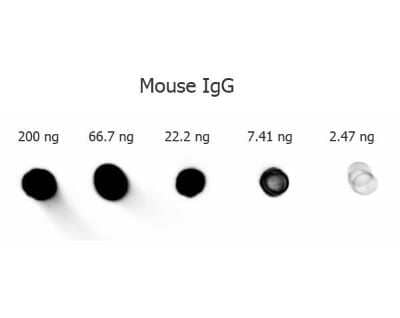Goat anti-Mouse IgG (H+L) Secondary Antibody [Alkaline Phosphatase] (Pre-adsorbed)
Novus Biologicals, part of Bio-Techne | Catalog # NBP1-72669


Conjugate
Catalog #
Forumulation
Catalog #
Key Product Details
Species Reactivity
Mouse
Applications
Dot Blot, ELISA, Immunohistochemistry, Western Blot
Label
Alkaline Phosphatase
Antibody Source
Polyclonal Goat IgG
Format
Pre-adsorbed
Concentration
Please see the vial label for concentration. If unlisted please contact technical services.
Product Specifications
Immunogen
Mouse IgG whole molecule
Specificity
This antibody was pre-adsorbed against Bovine, Chicken, Goat, Guinea Pig, Hamster, Horse, Human, Rabbit, Rat, and Sheep Serum Proteins. No reaction was observed against Bovine, Chicken, Goat, Guinea Pig, Hamster, Horse, Human, Rabbit, Rat and Sheep Serum Proteins.
Clonality
Polyclonal
Host
Goat
Isotype
IgG
Description
Store secondary antibody at 4C before opening. DO NOT FREEZE. Conjugated antibody is stable at 4C as an undiluted liquid. Dilute only prior to immediate use. Freezing alkaline phosphatase conjugates will result in a substantial loss of enzymatic activity.
This product was prepared from monospecific antiserum by immunoaffinity chromatography using Mouse IgG coupled to agarose beads followed by solid phase adsorption(s) to remove any unwanted reactivities. Assay by immunoelectrophoresis resulted in a single precipitin arc against anti-Alkaline Phosphatase (calf intestine), anti-Goat Serum, Mouse IgG and Mouse Serum
This product was prepared from monospecific antiserum by immunoaffinity chromatography using Mouse IgG coupled to agarose beads followed by solid phase adsorption(s) to remove any unwanted reactivities. Assay by immunoelectrophoresis resulted in a single precipitin arc against anti-Alkaline Phosphatase (calf intestine), anti-Goat Serum, Mouse IgG and Mouse Serum
Scientific Data Images
Dot Blot: Goat anti-Mouse IgG (H+L) Secondary Antibody [Alkaline Phosphatase] (Pre-adsorbed) [NBP1-72669] - Dot Blot of Goat anti-Mouse IgG antibody Alkaline Phosphatase Conjugated Min X Bv Ch Gt GP Ham Hs Hu Rb, Rt, Sh Serum Proteins. Antigen: Mouse IgG. Load: 200 ng, 66.7 ng, 22.2 ng, 7.41 ng, or 2.47 ng as indicated.Primary antibody: Anti-Mouse IgG antibody Alkaline Phosphatase Conjugated at 1:1,000 for 60 min at 4C.Secondary antibody: N/A.Block: Blocking Buffer for Fluorescent Western Blotting for 60 min at RT.
Applications
Application
Recommended Usage
ELISA
1:2000 - 1:10000
Immunohistochemistry
1:200 - 1:1000
Western Blot
1:500 - 1:2500
Application Notes
This product has been tested by ELISA an dot blot and is ideal for western blot, Immunohistochemistry and ELISA as well as other antibody detection methods; and are available in a variety of formats and conjugate types.
Formulation, Preparation, and Storage
Purification
Multi-step
Formulation
0.05 M Tris Chloride, 0.15M Sodium Chloride, 0.001M Magnesium Chloride, 0.0001M Zinc Chloride, 50% (v/v) Glycerol; pH 8.0, 10 mg/mL Bovine Serum Albumin (BSA) - Immunoglobulin and Protease free
Format
Pre-adsorbed
Preservative
0.1% Sodium Azide
Concentration
Please see the vial label for concentration. If unlisted please contact technical services.
Shipping
The product is shipped with polar packs. Upon receipt, store it immediately at the temperature recommended below.
Stability & Storage
Store at 4C. Do not freeze.
Background: IgG (H+L)
The 4 IgG subclasses, sharing 95% amino acid identity, include IgG1, IgG2, IgG3, and IgG4 for humans and IgG1, IgG2a, IgG2b, and IgG3 for mice. The relative abundance of each human subclass is 60% for IgG1, 32% for IgG2, 4% for IgG3, and 4% for IgG4. In an IgG deficiency, there may be a shortage of one or more subclasses (4).
References
1. Painter RH. (1998) Encyclopedia of Immunology (Second Edition). Elsevier. 1208-1211
2. Chapter 9 - Antibodies. (2012) Immunology for Pharmacy. Mosby 70-78
3. Schroeder H, Cavacini, L. (2010) Structure and Function of Immunoglobulins. J Allergy Clin Immunol. 125(2 0 2): S41-S52. PMID: 20176268
4. Vidarsson G, Dekkers G, Rispens T. (2014) IgG subclasses and allotypes: from structure to effector functions. Front Immunol. 5:520. PMID: 25368619
Additional IgG (H+L) Products
Product Specific Notices
This product is for research use only and is not approved for use in humans or in clinical diagnosis. Secondary Antibodies are guaranteed for 1 year from date of receipt.
